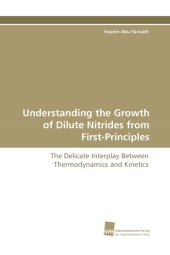 Neuerscheinungen 2010Stand: 2020-01-07 |
Schnellsuche
ISBN/Stichwort/Autor
|
Herderstraße 10
10625 Berlin
Tel.: 030 315 714 16
Fax 030 315 714 14
info@buchspektrum.de |

Hazem Abu Farsakh
Understanding the Growth of Dilute Nitrides from First-Principles
The Delicate Interplay Between Thermodynamics and Kinetics
2010. 176 S.
Verlag/Jahr: SÜDWESTDEUTSCHER VERLAG FÜR HOCHSCHULSCHRIFTEN 2010
ISBN: 3-8381-2215-1 (3838122151)
Neue ISBN: 978-3-8381-2215-1 (9783838122151)
Preis und Lieferzeit: Bitte klicken
Due to the large band-gap bowing associated with low N contents in III-V semiconductors, ternary and quaternary dilute nitride alloys have sparked interest over the last years for a wide range of technological applications. However, the realization of these alloys has been hampered by several challenges such as the extremely low equilibrium solubility of N and composition fluctuations. In order to overcome these challenges a detailed understanding of the growth of these alloys at the atomic level is crucial. Therefore, by employing state-of-the art first-principles calculations, this work provides (i) a detailed study of the thermodynamic N solubility limits at technologically relevant GaAs and InAs surfaces/subsurfaces as function of growth conditions, and (ii) the kinetic mechanisms for N adatoms that affect and control their incorporation, such as adatom diffusion and surface/subsurface substitution. A detailed analysis of the interplay between thermodynamics and kinetics allowed to predict the optimum conditions for N incorporation and to explain experimental results. This study provides a prototype for understanding the growth highly mismatched multi-component alloys.
has worked as a research associate at the Max-Planck-Institute for Iron and Steel Research in Düsseldorf/Germany, where he has obtained his PhD degree in physics from The University of Paderborn. After that he has moved to the materials department at the University of California Santa Barbara to do postdoctoral research.


